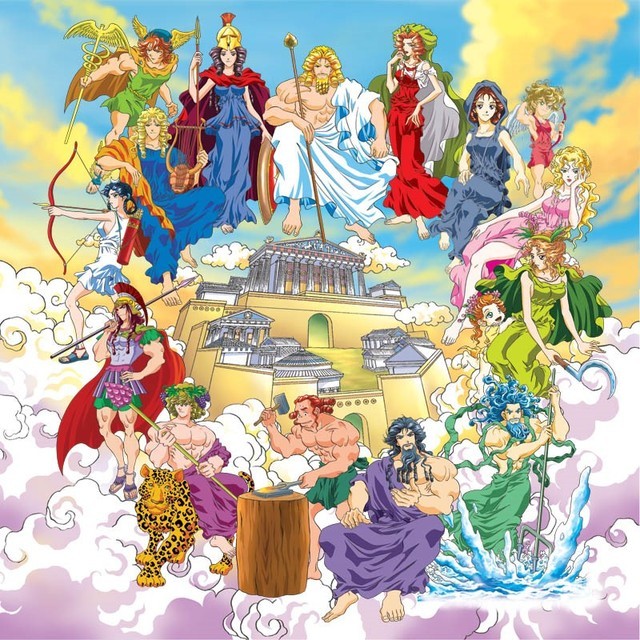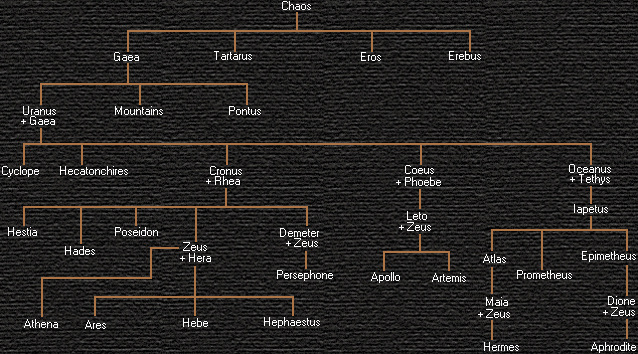

Ionic frieze: in the interior, on the outer wall of the naos (or cella), continuous relief sculpture renders the splendid Panathenaic procession described above.Doric frieze: on the exterior are metopes (relief sculpture) depicting four subjects: the battle between the Lapiths and the Centaurs the sack of Troy the Gigantomachy and the battle between the Greeks and the Amazons.On either side, figures of Athenian divinities and heroic kings are witnesses. West pediment: the contest between Athena and Poseidon, described above these two central figures pull away from each other as they produce the gifts with which they vie.At the corners, the horses of Helius (the Sun) and those of Selene (the Moon) set the momentous event in cosmic time.

Other divine figures are present at the miracle. East pediment: the dramatic moment of the birth of Athena, who stood in the center before the throne of Zeus, from whose head she had just spring, fully grown and fully armed.It is a most beautiful Doric temple (even in its ruined state today), and its sculpture (created under the aegis of the great Athenian sculptor Pheidias) bears tribute to Athena herself and her city and all that they mean forever. PARTHENOS, an adjective meaning "virgin," was a standard epithet of Athena. The PARTHENON is the great temple to Athena Parthenos on the Acropolis of Athens that was built in the fifth century B.C. Athenians (young and old, male and female) carrying sacred implements, leading sacrificial animals, with chariots or on horseback, figured in the procession. A Panathenaic procession wound its way through the city ending with the presentation of an embroidered robe (peplos) to Athena on the Acropolis. Important in the ceremonies were sacrifices and games the prizes for winners in the games were special Panathenaic amphoras-vases inscribed and decorated with a depiction of Athena and containing sacred olive oil. The PANATHENAEA, or PANATHENAIA, was an annual festival celebrating the birthday of Athena every fourth year the celebration of the Great Panathenaea was especially splendid. In his lovely temple the ERECHTHEUM, or ERECHTHEION, on the Acropolis, just across from the Parthenon, the marks of the blow of his trident supposedly could be seen, and nearby it, the olive tree that Athena had produced continued to grow. The olive was fundamental to Athenian economy and life.Īngry at losing, Poseidon was appeased and continued to be worshiped in Athens, especially in conjunction with the Athenian hero ERECHTHEUS (see MLS, Chapter 23). Athena brought forth an olive tree from the ground by the touch of her spear and she was proclaimed the victor. Poseidon struck the rock with his trident and produced a salt spring or a horse. Athena herself as victorious war goddess was called Athena Nike and the simple but elegant temple of Athena Nike stands to the right of the entrance to the Acropolis.Īthena and Poseidon vied for control of Athens and its surrounding territory, Attica. With her there may be a female winged figure (called NIKE, “victory”), bearing a crown or garland of success.

She is usually represented with helmet, spear, and shield or aegis that bore a depiction of the head of Medusa. She is associated with the owl and the snake. A dread goddess of war, she remained a virgin.Īthena bears an aloof kind of loveliness, akin to the beauty of youthful masculinity.
#Zeus poseidon and demeter full#
The occasion was awesome as Athena sprang forth fully grown, a beautiful young woman in full armor, fearlessly announcing her arrival with a thunderous war-cry.Īthena’s birth allegorically proclaims her essential character: her divine wisdom drawn from the head of god the special bond of affection between father and daughter her championship of heroes and male causes, born as she was from the male, and not from a mother’s womb. Hephaestus, with his ax, may have facilitated the birth. And so ATHENA, or ATHENE (MINERVA), was born from the holy head of Zeus. Zeus swallowed his consort METIS (“wisdom”), after he had made her pregnant, because he feared that she would bear a son who would overthrow him.


 0 kommentar(er)
0 kommentar(er)
